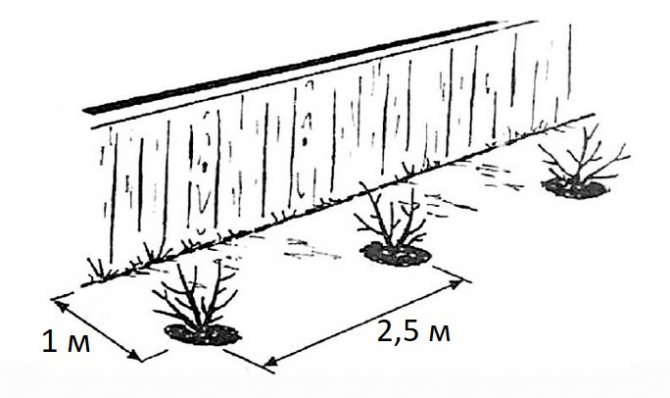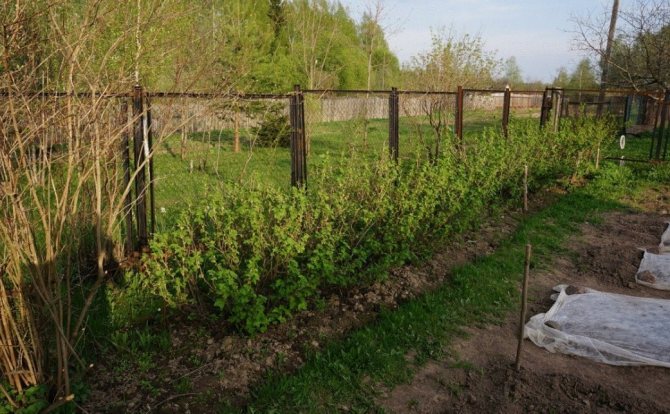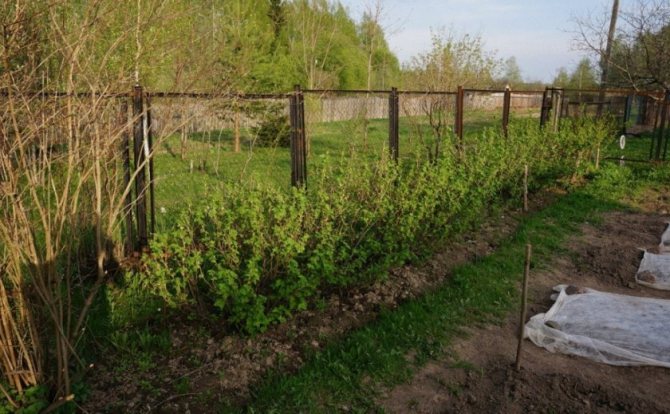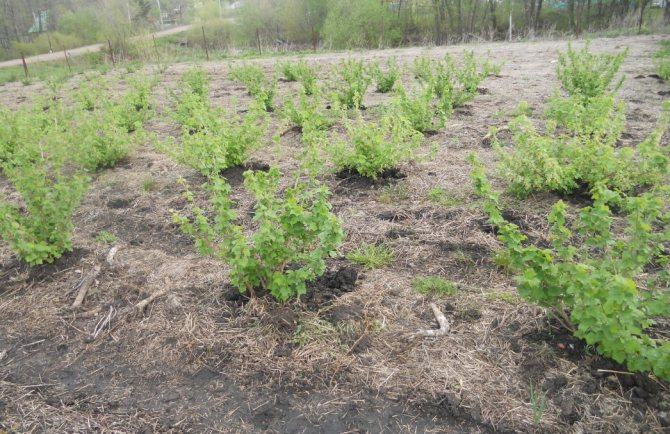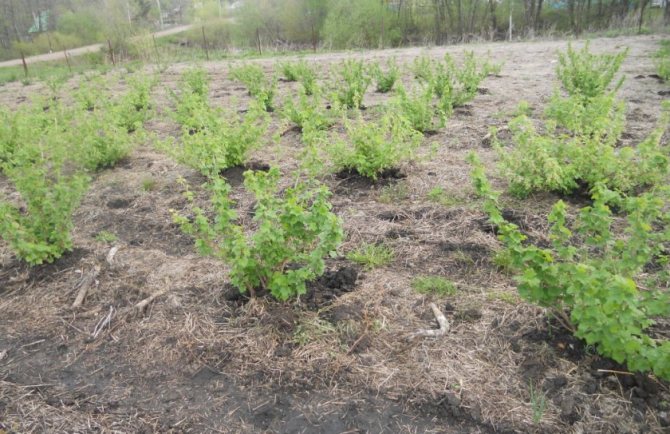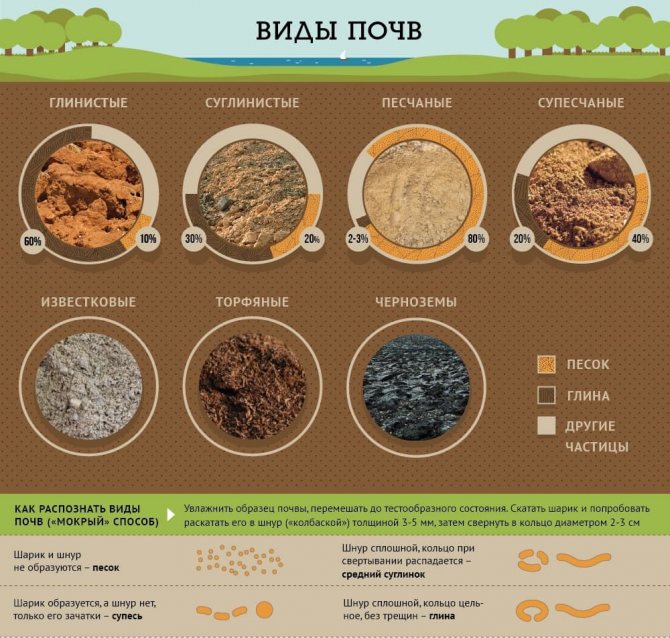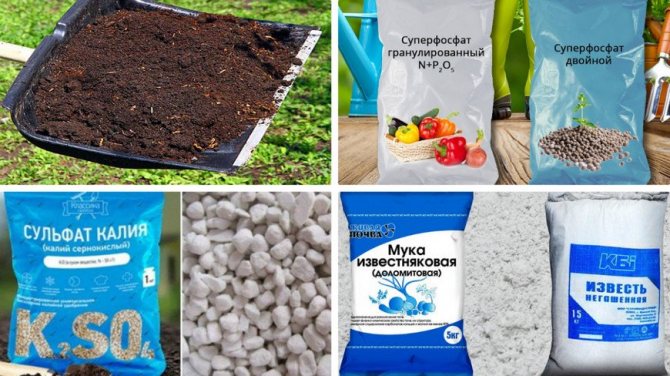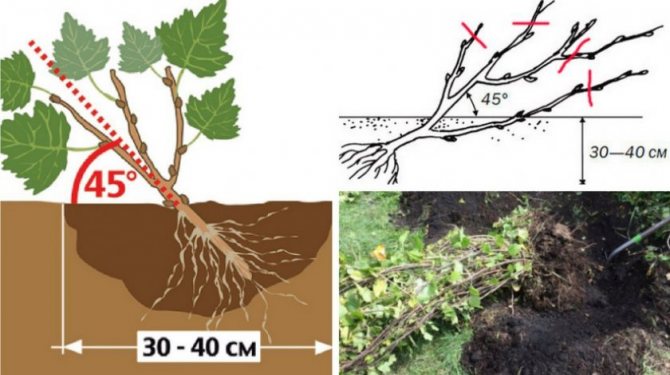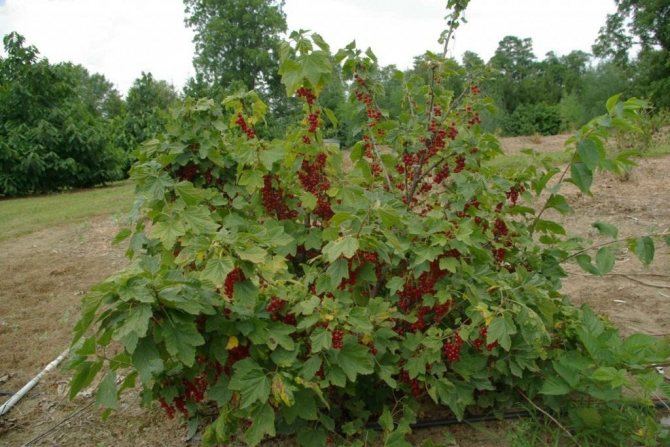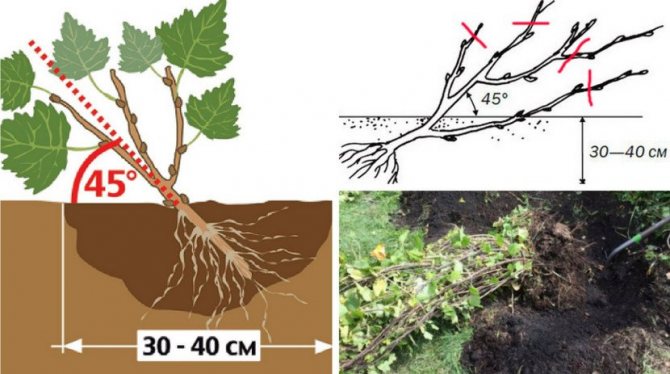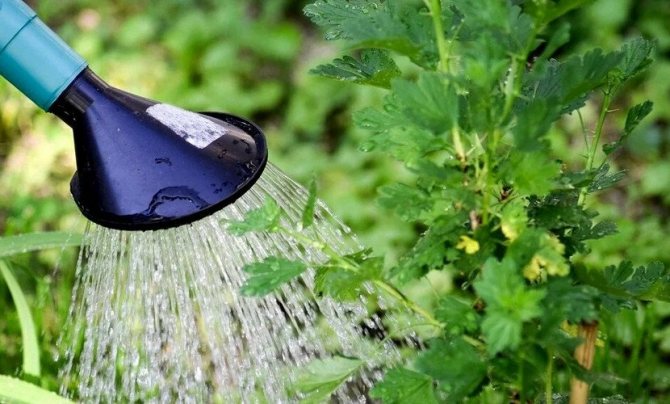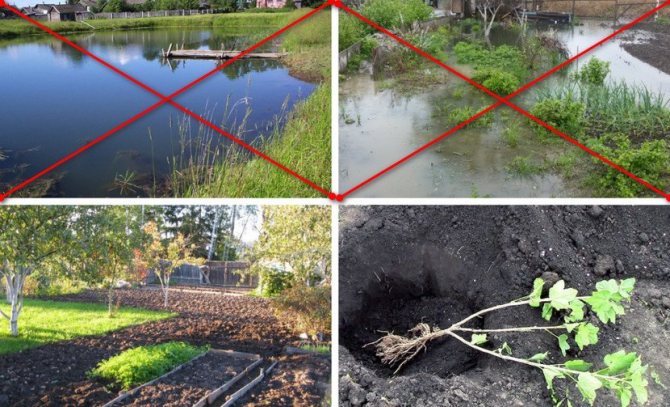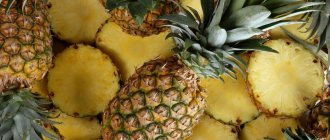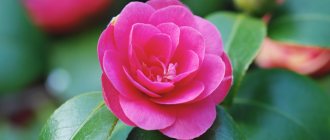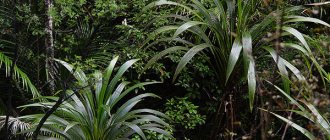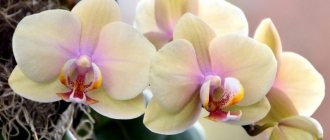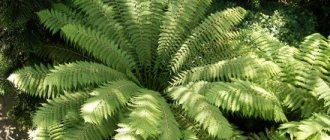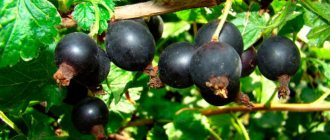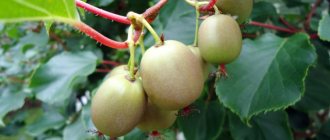
Currant is a common berry crop.
Often such bushes can be seen near fences or paths at a summer cottage.
This berry is not whimsical to care for, but has its own planting requirements, which differ depending on the variety.
In today's article, we will tell you where it is better to plant black, white and red currants.
Description of the plant
Currant is a shrub whose height ranges from one to five meters. Garden varieties, as a rule, do not exceed 1.5-2. The plant has long, straight shoots, brown, reddish or gray. The root system is branched and strong, going deep into the ground by about 1.5 meters.
Currant leaves have three or five lobes, serrated, round or elongated. The color of the foliage depends on the species, most often it is green, on the upper side the shade is brighter than on the lower.
Ornamental currant leaves can be of different shades: red, brown, crimson.
Flowers are different: from white to dark red. Inflorescences in the form of tassels, each of which gathers from five to several dozen flowers. Currants bloom in April or May, some varieties can bloom until June.
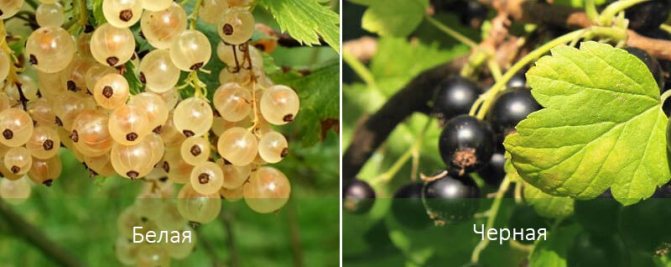

Currant fruits - berries, round or slightly elongated. The colors vary depending on the species, they can be red, black, white, green, yellowish. They also taste different.
Some varieties have a pronounced sour taste, some are sweet and sour, and there are also sweet varieties.
Features of different varieties
There are several types of currants, which differ not only in external indicators, but also in the place for cultivation.
Types of currants and their peculiarity:
Red
This variety has an elongated root system. It is worth planting such seedlings in dimples at least 60 cm deep. Red currants grow poorly in shaded areas. When choosing a territory, it is also worth considering the composition of the soil. The plant will not yield well in acidic and dense soils. Wetlands should be avoided.
The best place for red currants is soil, the acidity of which is in the range of 5.5 pH. This variety also prefers substrates with a high percentage of potassium. The amount of trace element per square meter should be about 31 grams.
Black
This variety has a shallow root system. The plant should be planted in areas with low humidity. Dry areas can damage the bush. It is forbidden to grow black currants in the shade. With insufficient light, the plant suffers from fungi and ages prematurely.
Advice! Do not plant red currants next to gooseberries.
The peculiarity of black currant is that it is able to tolerate moisture deficit in the soil well. In order for the bush to give a large harvest, it is worth maintaining an average soil moisture during the formation of buds. It is during this period that the plant needs water most of all.
Boarding: choosing a place and time
Planting currants is best done in early autumn. Until spring, the shrub will have time to take root. If this time of year turned out to be warm, you can plant the bushes in September and even at the beginning of October.With early frosts, it is best to wait until spring.
A planting site must be chosen where the plant will receive a lot of sunlight and moisture. If this is done correctly, then with good care the plant will bring a bountiful harvest for about 15 years.
Currants do not like shade and prefers areas where there is enough moisture. Black especially does not tolerate drought, other species are able to survive a lack of moisture for some time.
If the bushes have a small crown, then you can plant them closer to each other. Between spreading seedlings, it is better to make a larger distance. On average, you should leave 1.5-2 meters.
Step-by-step instructions for planting currants:
- small pits are prepared, about 40 cm deep;
- if time permits, then leave them for some time (a week or two) so that the soil shrinks;
- fertilizers, manure or compost are placed on the bottom;
- the hole is watered with water;
- the seedling is placed in a hole, tilted 45 degrees, the root system is straightened, then buried;
- the soil is tamped, gradually filling up the earth;
- cover open ground with mulch.
Inclined planting promotes better root development and additional shoots. The bush will be powerful and spreading.
If you plant a seedling straight, the bush will most likely grow into a single stem.
Soil requirements
A site for any variety of currants should be prepared in advance. If the planting of seedlings is planned in the spring, then the dimple should be done in the fall. This is necessary in order for the soil to settle. This process can be accelerated by pouring water over the well.
The bush develops well in slightly acidic soil. It is also important that the soil is light and loamy. Sandy ground is not suitable for the plant. Therefore, in order to harvest a large harvest of berries, you should put a small amount of clay before planting. This will help the soil to pass air and water well.
In order for the land to meet the plant's requirements, it must be improved. Organic or mineral substances should be added to the sandy loam look. The acidic earth should be limed. To do this, you will need to add slaked lime when digging. One hundred square meters will require 40 kg of funds.
Currant care
Those who have currant bushes in their country house should take into account that these plants love moisture. If there is no rain for a long time, the shrubs should be regularly watered.
Lack of moisture will lead to shedding of the berries, and the rest will be small and tasteless.
You should also periodically loosen the ground, at least once every three weeks. It is not necessary deeply, 5-8 cm is enough. When loosening, care must be taken so as not to damage the roots of the plant.
Caring for currant bushes includes:
- the soil around the plant must be weeded regularly, freeing it from weeds;
- it is imperative to apply mulch to the surface of the soil around the bush - a layer that retains moisture, prevents weeds from growing, protects against temperature changes;
- before freezing, the bush should be wrapped with cloth or paper; containers with water should be placed under the plant.
The lower branches of the currant bush can creep along the ground. To avoid this, you should build a support around.


In order for the plant to develop well and bear fruit, it should be provided with feeding. Fertilizers applied during planting are enough for about two years. After that, regular fertilization should be ensured. This is compost in an amount of about 5 kg and 20 g each of potassium sulfate and superphosphate.
In the spring months, when the plant wakes up from hibernation and begins to grow actively, it is necessary to provide it with top dressing for the roots. For this purpose, manure or chicken droppings diluted with water, as well as store products, are suitable.
In order for the bush to grow and develop well, it is necessary to regularly prune its branches.The annual mandatory pruning is done in the spring. This removes the branches:
- affected by disease;
- damaged by pests;
- curved;
- broken;
- old.
Pruning old, weak, damaged branches will enable the plant to sprout new strong shoots.
In summer, currants should be watered regularly, loosened the soil, treated with insecticides and fungicides. It is especially important to properly water the plant during flowering and fruiting.
Also, currants need pruning in August, after harvest. In this case, two or three main branches are cut out to the very root, without even leaving a hemp. By doing this in the summer, after picking the berries, you can make room for young basal shoots.
Gardening tips
In order to create a beautiful garden, it is necessary to provide competent placement, taking into account compatibility. It is advisable to select separate areas for different plant species. If this is not possible, they retreat several meters from the fruit trees so that they do not shade the currants. It is recommended to proceed as follows:
- Select areas with a groundwater level of at least 1 m from the ground surface.
- Choose a flat piece of land. A slight slope is allowed. For a good harvest, it is important that water and cold air do not stagnate. Areas with a height are not suitable for currants, since in the summer the bushes suffer from dry winds.
- Remove wheatgrass along with the roots or pre-treat the soil with herbicide so that the weed does not drown out young currants and reduce the quality of the harvest of mature bushes.
- Plant three bushes in each hole in order to increase the yield by 2-3 times. In this case, an angle of 45 ° is also maintained.
- Prepare foliar dressing in cloudy weather. During the flowering period, the plants are sprayed with a product prepared on the basis of manganese sulfate (1 tsp) and boric acid (0.5 tsp). The components are dissolved in 10 liters of warm water with a temperature of up to 40 ° C. When forming ovaries for the same amount of liquid, use a glass of superphosphate and 3 tbsp. l. urea. In cloudy weather, plants absorb nutrients better, the yield and quality of berries increase several times.
Currants do not require special care, it is enough to provide basic conditions. However, in order to increase yields, it is worth listening to the advice of experienced gardeners and making additional manipulations. The planting of bushes is carried out taking into account the norms for planting plants, if necessary, they are agreed with the owner of the neighboring site.
Sources:
Reproduction
Reproduction of currants can be carried out in three ways:
- cuttings;
- dividing the bush;
- layering.
The first method is considered the most effective, especially if there is not so much material, but you want to save the variety. You can propagate currants in this way in summer, spring, and autumn.
This should be done in an already prepared substrate, consisting of soil with the addition of compost and manure. Lignified annual shoots are taken as cuttings in autumn and spring, which are most conveniently preserved during annual pruning.
It is necessary to choose branches with a diameter of at least 6 mm. The length of the cutting is about 20 cm, it must have buds (3-4 pieces).
At the bottom, the stalk is cut directly under the kidney; in the upper part, an incision is made just above it. It is planted at an angle in the prepared soil, watered, and mulch is placed on top.
Reproduction by dividing the bush is not the most common method. It is used if the plant needs to be transplanted to a new place, as well as in cases where there is not enough planting material. With this method, the bushes take root fairly quickly without additional effort. They should be divided in autumn or spring.This is simple to do: the plant is removed from the ground, while you need to make sure that the roots are not damaged during digging, after which all old and diseased branches are chopped off, and it is divided with a sharp ax into several parts (usually three or four). This must be done so that each part has well-branched roots, and the branches have buds.
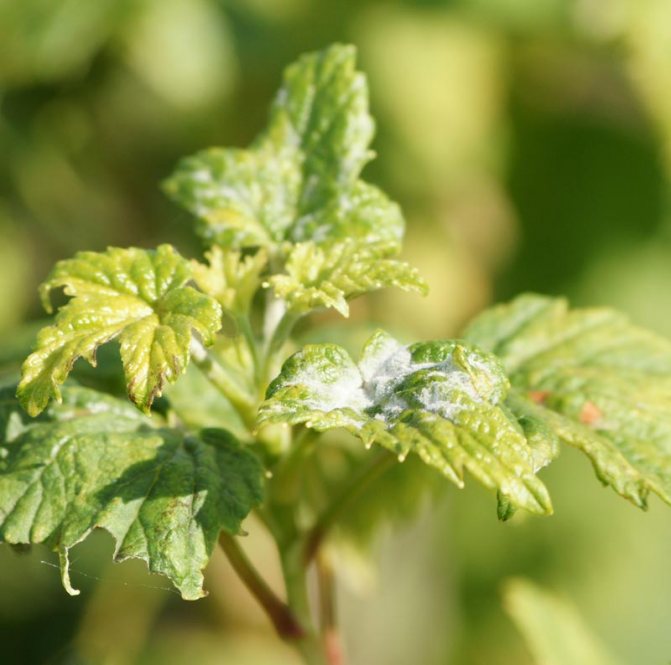

One of the easiest ways to propagate currants is the layering method. It is necessary to carry out the procedure in early spring, while the plant has not bloomed. Several shallow grooves (6-7 cm) are dug around the bush, which is chosen as the parent. Then the lower branches (strong and young shoots should be chosen) are cut (by about a third) and bent to the ground, placed in a dug groove and fixed (usually wire is used for this purpose).
5-7 shoots can be taken from the mother bush.
It is not necessary to sprinkle the branches, they do this only when green branches appear on them and when they reach 10-15 cm. Then the grooves where the retracted shoots are located are sprinkled with soil. They should be spud twice or three times over the summer. By the fall, they already have well-developed roots, and they can be transplanted to the chosen place.
What should be the seedling?
Currants are quite durable - they can bear fruit well for 15 and more years
, subject to proper care. It is important that the seedling is initially healthy. Therefore, when choosing planting material, you need to know the following:
- A two-year-old seedling with two or three shoots is best suited.
- He must be healthy. This means that he should look cheerful, not have signs of wilting. In addition, shoots, leaves or buds should be free of any fungal stains.
- The root system must have at least three skeletal roots 20 cm long. If the plant is in a pot, then you need to remove the earthen ball. It should be well braided with plant roots, which indicates a developed root system. This must be done without fail, since the state of the underground part determines how quickly and successfully the plant will take root.
- Currants are often affected by various diseases, so it is better to give preference to varieties that are resistant to pests and diseases. For example, varieties of black currant have proven themselves well: "Selechinskaya 2", "Annadi", "Hercules", "Orlovia", "Sudarushka". Resistant red currant varieties: Jonker Van Tets, Konstantinovskaya, Gazelle, Valentinovka, Rondom.
Diseases and pests
Like other plants in our latitudes, currants are susceptible to disease and can be affected by pests. The most common illnesses include:
- Anthracnose is a fungal disease in which the leaves begin to dry out and curl, turning brown. Patients must be cut off from the bush and disposed of at the stake, and the plant itself must be sprayed with a fungicide.
- Powdery mildew (ash) - an infection caused by microscopic parasitic fungi, the plant sprinkles a white bloom. It is necessary to fight this scourge with the help of copper sulfate (dilute 30 g in 10 liters of water and spray the bush).
- Striped mosaic is a viral infection characterized by the appearance on the leaves of a bright pattern formed by yellow veins. The infected bush will have to be destroyed, it is useless to treat it, so measures must be taken to protect the plant from vectors of infection - aphids and ticks.
- Terry (reversion) is a dangerous viral disease, to which black currants are most susceptible, they infect a plant with aphids and ticks, it ceases to bear fruit. To protect against vectors, insecticide treatment is necessary, and to get rid of reversion - spraying with Bordeaux liquid.
- Septoria is a fungal disease in which the leaves are first covered with brown spots, and then become whitish.To get rid of white spot, you should treat the shrub with fungicides.
The most dangerous pests of currants include aphids, glass caterpillars, leaf gall midge. To remove aphids and gall midges, a solution of karbofos is used. A mixture of ash, dry mustard and pepper, tobacco will help get rid of the glass case. The ingredients are mixed in equal proportions and applied under the plant.
Useful properties of currants
Currant has a very rich composition: it contains many vitamins, especially vitamin C, as well as groups B, E, K, F, useful carbohydrates (fiber), many valuable organic acids.
There is so much vitamin C in black currants that about 50 grams of berries provide the daily requirement of an adult.
It is very useful to use currants in order to strengthen the immune system, to fight infectious diseases. The rich chemical composition helps to kill pathogenic microorganisms, therefore, drinking currant fruit drinks and eating fresh berries is indicated during the period of antibiotic treatment. Decoctions from them help to remove toxic substances and heavy metals from the body.
Currant fruits can be dried, frozen, made from them compotes, preserves, jams. To preserve vitamins, many housewives prefer to grind berries with sugar, in this form they are perfectly stored and help in supporting immunity in winter. They also contribute to the rejuvenation of the skin and the whole organism. For this purpose, it is useful to use them internally, but masks can also be made. Due to the content of fruit acids, such procedures have the properties of a light chemical peeling.
Not only the fruits of the shrub are useful, but also its leaves. They are used to add flavor and aroma to homemade preparations, and a decoction or tea from them acts as an excellent diuretic. It is recommended to take it for kidney and bladder diseases.



